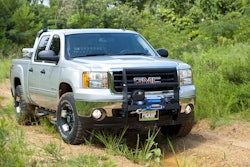ABOUT THAT DEF
“I’ve been looking around at new diesels and plan to sell my ‘02 Super Duty. The new Ford engines are pretty sweet. How about a little insight on that extra fluid that works with the exhaust? Any concerns I should have about that aspect?” – Lester Meekens via e-mai
Don’t be concerned but do become familiar with this extra fluid because without it your truck will cease to run. Generically, the stuff is called Diesel Exhaust Fluid, or DEF for short. It’s required for almost all diesels from 2010 on as a result of EPA clean air mandates, although in this case it’s an environmental regulation we wholeheartedly endorse. It cuts NOx, a prime ingredient of smog by 95 percent.
The system that uses DEF is called selective catalytic reduction or SCR. In trucks thus equipped the exhaust leaves the engine it goes through a soot filter and then through a diesel oxidation catalyst. The DEF fluid is sprayed as a fine aerosol into the oxidation catalyst and when it hits the exhaust stream in the presences of the rare earth metals in the DOC it chemically transforms the NOx into harmless water and nitrogen.
It doesn’t take much DEF to do the trick. For a pickup truck you should only have to refill the 5- to 6-gallon DEF tank (it sits at the back of the fuel tank on new Fords) once every oil change or so depending on duty cycle. But don’t let it run out. If you do, sensors in your truck will give numerous early warnings of low DEF levels, and if ignored, slow the engine to a crawl and then stop altogether when the fluid runs out.
As for storage, keep DEF away from extreme heat and cold; high heat will shorten the shelf life, and DEF is a solution of urea and water so it will freeze. But after freezing it thaws out with no degradation.
As for toxicity, it’s slightly caustic, but no worse than windshield wiper fluid. You can buy it in a variety of container sizes from one gallon up to 375-gallon totes for fleet use. And at many truck stops you can pump it just like you do diesel. The price for DEF should be about the same as for diesel fuel. —Editors
TUNE UP TANKS MILEAGE
I have an ’03 Chevrolet 2500HD Crew Cab 4×4 LB7 diesel that has a Hypertech programmer and 215,000 miles on it. We recently replaced the fuel pump, injectors and glow plugs. After the repairs we lost 3-4 miles per gallon running empty. Any reason why the new parts would give us worse fuel economy? – Steve Miller, Dallas, TX
We suspect your right foot is a lot heavier now than it was before the rebuild. But we asked the engineers at Hypertech if they might have a clue. Here’s what they said: When replacing injectors, the flow numbers for the new injectors should be entered into the PCM and Glow Plug module with a factory scan tool. Also, the injector spray nozzle/pattern should be identical to the factory nozzle/pattern. The factory pattern is designed to focus one jet of fuel directly at the glow plug to aid in startup and fuel atomization.
It could be beneficial to disconnect the batteries for a short period of time (about 15 minutes) and depressing the brake pedal to discharge any residual voltage. This should reset the ECU back to the zero for any prior learned fueling adjustments.
Diesel MPG
Why aren’t fuel economy numbers listed for diesel? I’d like to know what the fuel mileage is on the new F-250/350 6.7L but it’s not listed on the EPA window stickers. – Henry Ruggiero, New Jersey
Currently the EPA excludes vehicles with a Gross Vehicle Weight Rating greater than 8,500 pounds (or a curb weight greater than 6,000 pounds), which includes all heavy-duty pickups. That said, you should expect the typical diesel pickup to get about 30-percent better fuel economy than a comparable displacement gas-powered pickup due to burn efficiency alone. Our highway fuel economy tests show the 2011 F-250 Super Duty 6.7L Crew Cab 4×4 gets 19.6mpg at 70mph and 14.7mpg in town. Those unladen figures should be representative of real-world operation. – The Editors
WARNING MESSAGE
A warning came up on my 2011 F-350 that says “Drive To Clean Exhaust Filter” and by the time I got back to the shop it was off and has never popped up again. Should I be concerned? – Ben Jenkins, Portland, OR
No worries. Here’s what your owner’s manual says on Page 56: “When the engine control module detects that the DPF is nearly full of particulates and that the vehicle is not being operated in a manner to allow effective automatic cleaning, the message center will display DRIVE TO CLEAN EXHAUST FILTER guiding the vehicle operator to drive in order to clean the DPF. If the vehicle is operated in a manner to allow effective automatic cleaning, the message center will display CLEANING EXHAUST FILTER, which is the normal regeneration process. See Message center in the Instrument Cluster chapter of the Owner Guide for more information.” – The Editors
GOT QUESTIONS?
Send them to Bruce Smith at [email protected]






